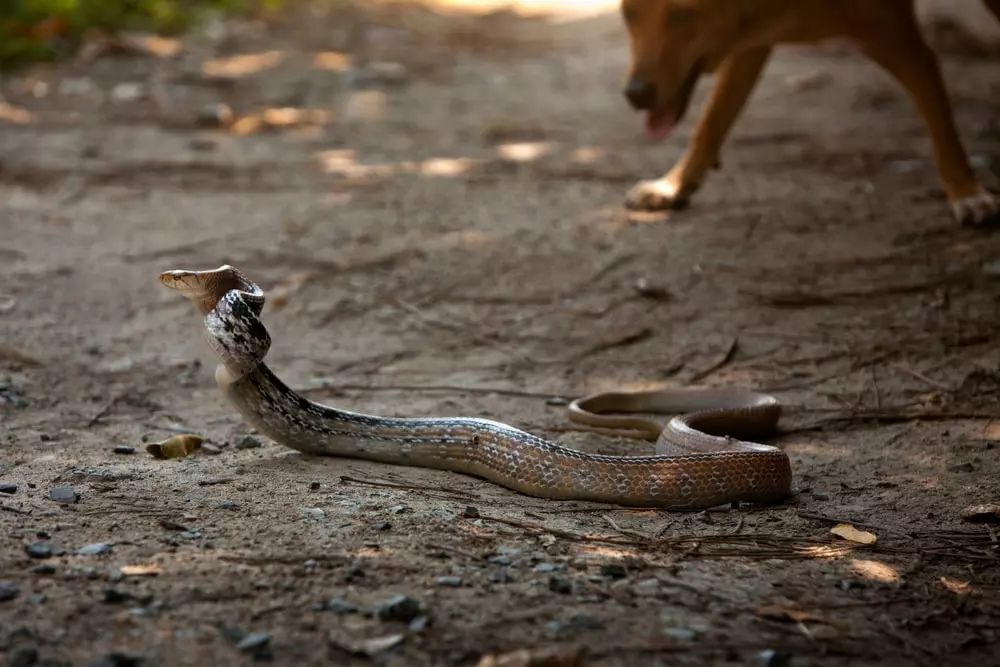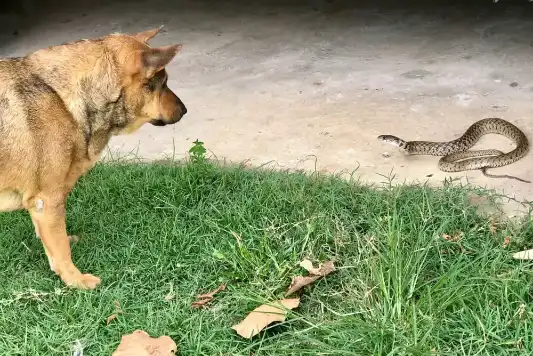PET HEALTH
Sometimes, our dogs’ curiosity can get the best of them. When it comes to things out in the wild, dogs can tap into their natural instincts and chase, hunt, or even play with potentially dangerous animals such as snakes.
Encountering a snake can be scary enough, but what if your dog gets bit by a snake? Read on to learn more about the symptoms of a dog snake bite, what to do if your dog gets bitten by a snake, and how to prevent it in the future.
Symptoms of a Dog Snake Bite
If you think your dog has been bitten by a snake, there are a number of signs to look out for. While not all snake bites can result in serious symptoms, it’s important to be proactive and observe for the following dog snake bite symptoms:1
- Pain or swelling at the site of a bite (typically on the face, neck, or legs)
- Collapsing or sudden weakness immediately after a bite, followed by normal behavior
- Dilated pupils
- Excessive drooling
- Vomiting
- Diarrhea
- Paralysis
- Hind leg weakness
There are a few factors that can impact the severity of these symptoms, including:1
- The type of snake
- Where the bite occurred
- The amount of venom injected, if any
Regardless of the severity of your dog’s symptoms, it’s a good idea to take them to a veterinarian’s office or emergency clinic as soon as you can. Snake bites in dogs don’t all appear the same way or with the same set of symptoms, so it’s recommended that you get your dog examined and treated quickly.
While non-venomous snake bites may not be fatal, infection can still occur at the site of the bite. When venom is involved, time is precious and early intervention is key to help prevent potentially fatal complications.1
A vet will likely ask you to describe the snake that bit your dog, so take note if you can. Please know that it’s not safe to attempt to catch or kill the snake, as you’ll be risking additional injury towards yourself and your dog.
What does a snake bite look like on a dog?
Snake bites generally appear as puncture wounds on the skin. It can sometimes ooze blood depending on how deep the bite is or if venom was injected. Snake bites can also cause swelling or bruising around the affected area.2
Treatment Options for Snake Bites
When it comes to diagnosing and treating a snake bite, time is of the essence. Experts recommend administering first aid while you’re on your way to the vet’s office to minimize the effects of a potentially venomous bite. Here’s what you may want to do:1
- Rinse the site to remove any venom that hasn’t yet made it to the bloodstream.
- Try to prevent your dog from moving and keep the area of the bite below their heart to help slow the spread of venom throughout their body.
- If needed, wrap the wound to protect it and help prevent your dog from licking or biting the area.
- It’s recommended to perform CPR on your dog if they stop breathing at any point during transportation.
Not knowing exactly how to treat a snake bite on a dog can be scary, but staying calm as you await care from a professional can help. Dogs can sense feelings of uneasiness in their humans, so try to calm them down by remaining calm yourself.
Once you see a vet, they’ll conduct an exam, typically bloodwork, to determine if venom is present in your dog’s blood. If you couldn’t identify what type of snake bit your dog, your pup will still be given treatment. If venom is detected, your vet will usually administer antivenom and likely keep your dog hospitalized for at least 24 hours. During your dog’s hospital stay, the vet may conduct additional testing and monitor them for any changes to their health.1
If the snake bite is from a non-venomous snake, your vet may treat it like a puncture wound.3 They might clean the wound, provide antibiotics to prevent infection, and may recommend antihistamines to control any swelling and discomfort your dog might experience.3
Snake Bite Prevention
The best form of protection is prevention, and that’s especially true for snake bites. Rattlesnake vaccinations are available for dogs and, while it doesn’t prevent the bite from happening, it provides you more time to get to the vet for emergency care in the event of a rattlesnake bite.
Knowing where dangerous snakes roam can also help you prevent your dog from a potential injury. States like California, Florida, and Texas are home to several types of snakes, including venomous snakes. Snakes tend to reside in log and leaf piles, trash heaps, holes, dense brush, tall grass, and anywhere they can find prey.
How to identify a venomous snake
One way to prevent a potentially fatal snake bite is to be able to identify venomous snakes. Typically, venomous snakes have cat-like pupils that are thin and vertical. All pit vipers — like copperhead snakes or rattlesnakes — will have distinct slanted pupils. If the snake has round pupils, they typically aren’t venomous, but it’s not recommended to presume that on a snake’s eye shape alone.
In any case, it can be hard to look a snake in the eye if they’re slithering at your dog quickly. It’s best to avoid any encounter with a snake by removing yourself and your dog as quickly as possible.
How Pet Insurance Can Help Canine Snake Bite Victims
If your dog has been bitten by a snake, vet bills may be inevitable. On top of that, if your dog needs extensive care and recovery after a venomous snake bite, those bills can easily stack up. With a dog insurance policy through MetLife Pet Insurance, you could be reimbursed for covered expenses like exam fees, hospital stays, and necessary medications.3 This could help ease the financial stress of those vet bills. Get a free quote to see how pet insurance can fit into your life.


